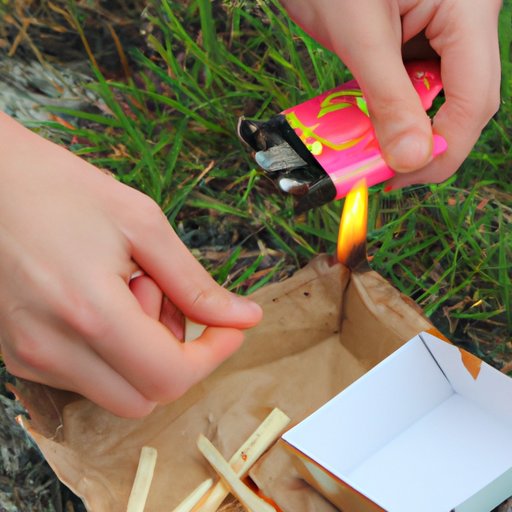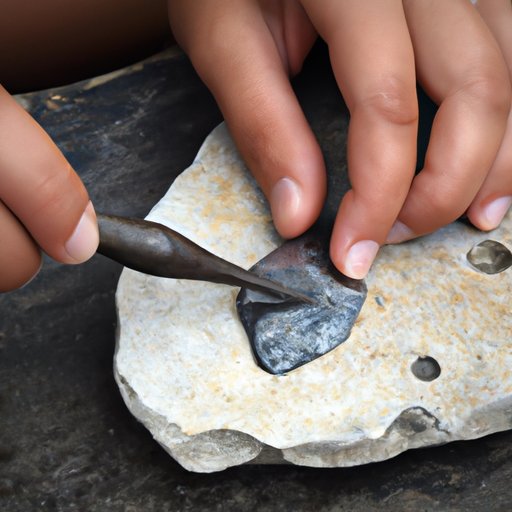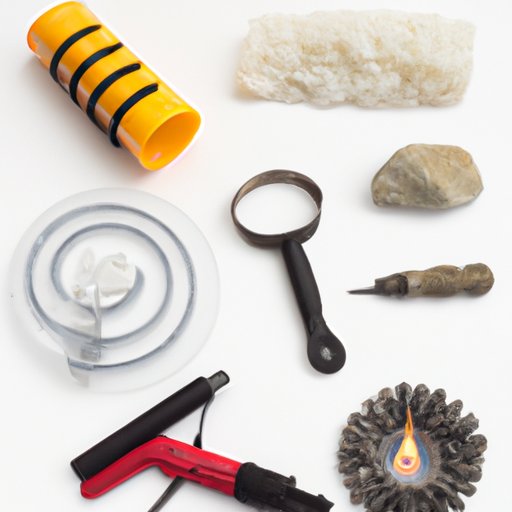Introduction
Starting a fire can be a daunting task for many people, especially those who are new to camping or survival skills. The purpose of this article is to provide an overview of different methods you can use to start a fire, as well as the steps you need to take in order to do so successfully. We will discuss using a fire starter kit, striking rocks together, using a magnifying glass, using a battery and steel wool, using a hand drill, using a bow drill, and using a flint and steel.

Using a Fire Starter Kit
A fire starter kit is a great way to get a fire going quickly and easily. It typically consists of a combustible material such as wax or sawdust, kindling, and matches or a lighter.
In order to assemble the kit, you will need to gather the necessary materials. You can purchase pre-made kits from outdoor stores, or you can make your own. To make your own kit, collect small pieces of wood such as twigs, bark, pine needles, and leaves. Place these in a container such as a Ziploc bag or a tin can. Add some combustible material such as wax, sawdust, or lint. Finally, include some matches or a lighter.
Once you have assembled your kit, it’s time to get the fire going. The first step is to create a structure with the kindling that will help the fire burn. This is called a “teepee” or “log cabin” structure. Once the structure is built, light the combustible material with the matches or lighter. Once the combustible material is lit, the kindling should catch fire quickly.
Striking Rocks Together
Another method for starting a fire is striking two rocks together. This is a primitive method that has been used for centuries. In order to do this successfully, you will need to find the right type of rocks. The best rocks for this method are flint and quartz, which can be found in most areas.
Before you begin striking the rocks together, you need to prepare them. Start by finding two flat, smooth surfaces on each rock. Next, place a piece of char cloth or tinder on the ground between the rocks. Strike the flint against the quartz in short, sharp strokes. Sparks from the rocks should land on the char cloth and ignite it.
Once the char cloth is lit, you can blow gently to encourage the flame to grow. You can then add kindling and larger pieces of wood to the fire.
Using a Magnifying Glass
Using a magnifying glass is another easy way to start a fire. The best type of magnifying glass to use is one made of borosilicate glass, which can be purchased at most outdoor stores.
To set up the magnifying glass, position it so that the sun is reflecting off of it and onto the char cloth or tinder. The sun’s rays should be focused on the char cloth, which should ignite after a few minutes. Once the char cloth is lit, you can blow gently to encourage the flame to grow. Then, add kindling and larger pieces of wood to the fire.
Using a Battery and Steel Wool
Using a battery and steel wool is another quick and easy way to start a fire. For this method, you will need a 9-volt battery and fine grade steel wool.
To prepare the battery and steel wool, connect the two items together by touching the positive (+) and negative (-) terminals of the battery to the steel wool. When the two items are connected, the steel wool should spark and ignite. Blow gently to encourage the flame to grow. You can then add kindling and larger pieces of wood to the fire.
Using a Hand Drill
Using a hand drill is a more advanced method for starting a fire. This method requires the use of a spindle, hearth board, and bearing block. The spindle should be made of dry, hardwood such as oak or maple. The hearth board should also be made of dry, hardwood. The bearing block can be made of any material, such as stone or antler.
To construct the drill, place the spindle on top of the hearth board. Wrap the string around the spindle and tie it securely. Place the bearing block on top of the spindle and press down firmly. Begin spinning the spindle by rolling the bearing block back and forth. This will create friction and heat, which should ignite the char cloth or tinder. Once the char cloth is lit, you can blow gently to encourage the flame to grow. Then, add kindling and larger pieces of wood to the fire.
Using a Bow Drill
The bow drill is similar to the hand drill, but requires the use of a bow instead of a bearing block. To construct the bow drill, you will need a spindle, hearth board, bow, and cord. The spindle should be made of dry, hardwood such as oak or maple. The hearth board should also be made of dry, hardwood. The bow should be made of flexible wood such as willow or yew. The cord should be made of natural fibers such as hemp or jute.
To use the bow drill, place the spindle on top of the hearth board. Wrap the cord around the spindle and tie it securely. Place the bow on top of the spindle and press down firmly. Begin spinning the spindle by pushing and pulling the bow back and forth. This will create friction and heat, which should ignite the char cloth or tinder. Once the char cloth is lit, you can blow gently to encourage the flame to grow. Then, add kindling and larger pieces of wood to the fire.

Using a Flint and Steel
Using a flint and steel is another method for starting a fire. The best type of flint and steel to use is high carbon steel, which can be purchased at most outdoor stores.
To prepare the flint and steel, place the flint on a flat, stable surface. Strike the steel against the flint in short, sharp strokes. Sparks from the steel should land on the char cloth and ignite it. Once the char cloth is lit, you can blow gently to encourage the flame to grow. You can then add kindling and larger pieces of wood to the fire.
Conclusion
We have discussed several methods for starting a fire, including using a fire starter kit, striking rocks together, using a magnifying glass, using a battery and steel wool, using a hand drill, using a bow drill, and using a flint and steel. Each of these methods has its own advantages, and learning how to use them can be invaluable in an emergency situation. With practice and patience, you can master the art of fire starting.
(Note: Is this article not meeting your expectations? Do you have knowledge or insights to share? Unlock new opportunities and expand your reach by joining our authors team. Click Registration to join us and share your expertise with our readers.)
